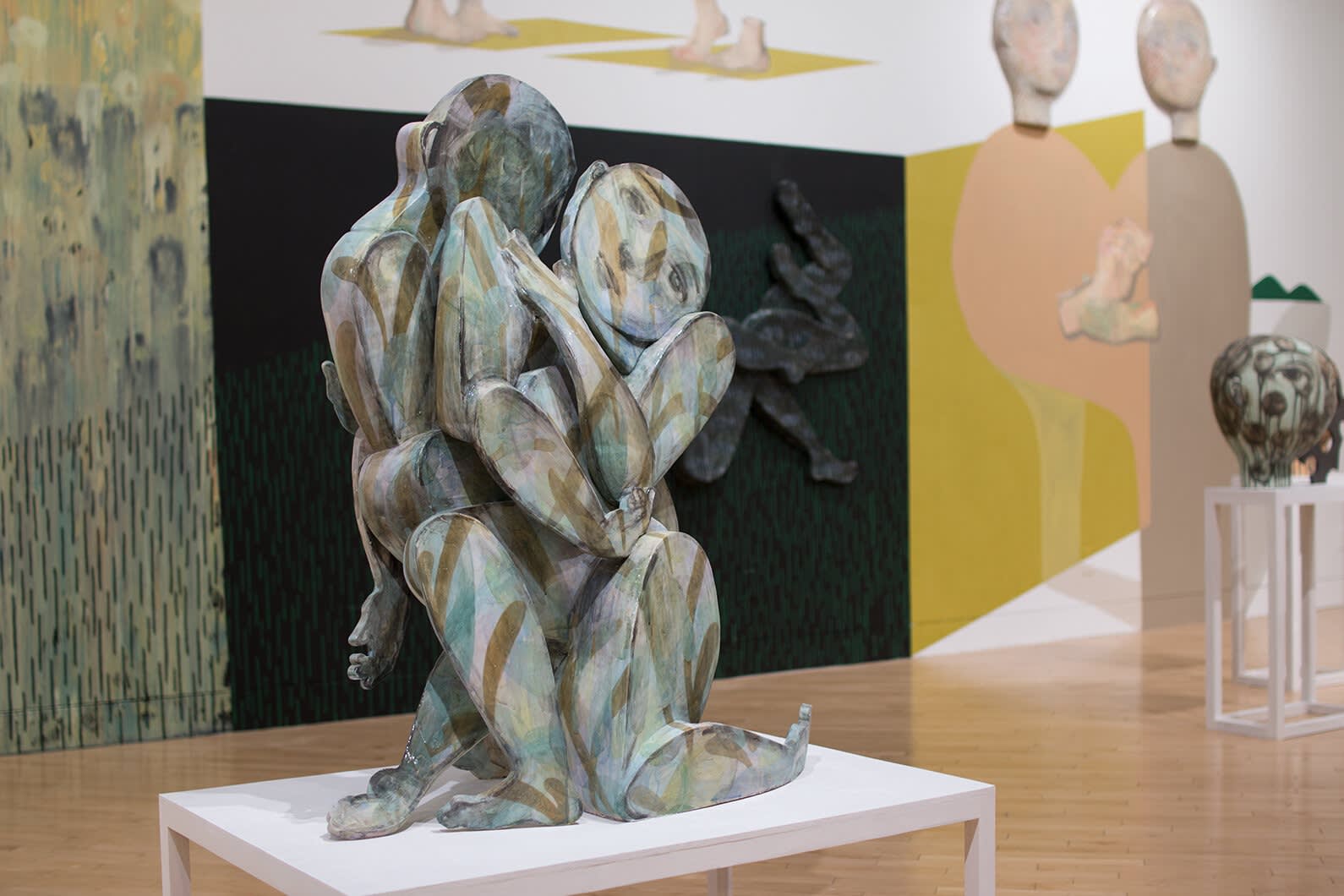Read on the Independent Record
Entering the Holter Museum of Art’s High Gallery, one’s eyes are immediately drawn to a towering green figure looming above -- its head bent sideways.
Nearby, two small figures are huddled on the floor. One points a finger. To what?
A few steps away, two figures embrace with limbs intertwined.
Who are they?
An embodiment of love? Lust?
Their facial expressions seem oddly neutral and emotionally detached.
Some figures are just a few body parts or gestures floating along the wall mural.
As one’s eyes focus in -- how does the wall mural connect with the sculptures around it and within it?
Some viewers find it unsettling that they can’t label her figures, Soojin Choi said.
What am I feeling?
What are they feeling?
And what am I really seeing?
Don’t expect a clear answer.
Choi, who grew up in South Korea, but now lives and studies in the United States, is exploring the ambiguity of emotions. The inspiration for the exhibit, she said in a Zoom interview, grows out of living between two cultures -- and not really feeling part of either.
She lived in Korea until after high school graduation and has lived in the United States for 12 years, and English is her second language.
"There’s a cultural difference about emotions,” she said. “We all humans. We can be empathetic about certain emotions. It all depends on a culture.” She feels like a foreigner here, and “when I go back to Korea, I feel foreigner now. I feel foreigner everywhere now.
“It kind of makes me feel isolated.”
It is that “betweenness” that she is exploring through her art.

While she was exploring emotions, Soojin Choi found herself digging into the seven deadly sins, and trying to understand why a human emotion would be labeled a “sin.”
She was inspired by the Brad Pitt movie “Se7en,” which incorporates the seven deadly sins in its plot. (For those not up on your sins -- these are pride, greed, wrath, envy, lust, gluttony and sloth.)
“How I’m doing art, I’m thinking of the narrative as a movie,” said Choi, who is a movie lover. “So, when I’m deciding a gesture or where the face is going to be, I’m thinking of a frame of a movie.”
Her exhibit title is a subtle nudge to viewers to see the emotions she’s portraying and to see emotions as natural, rather than as something forbidden.
She notes that certain emotions -- say jealousy -- can be seen as bad in America, but in South Korea, to have a jealous boyfriend could be a compliment.
“You need to accept what you feel. If you accept it -- you can be jealous, it can be a way of talking about it,” she said.
She sees her installation as a frame in a film or a scene in a play that a viewer can walk through and create their own narrative. In her artist statement, she wrote: “The ambivalence of human emotion occurs through unresolved and confusing situations... An ambivalent moment reveals itself to me, and I depict that gray area of humanity. I recount these unsettled situations so viewers can empathetically encounter the emotions of the human forms I create.”

The exhibit questions “what a bad emotion is in our contemporary consciousness. From traditional and cultural vices, I believe that ‘sins’ -- or the emotions that result in 'sin' -- are the most instinctive part of humanity. In this exhibition, I explore the beauty of each emotion itself. These emotions are pure and I repurpose towards finding natural-born humanity and internality by displaying them in a delightful and sacred place. I enlist the ‘bad’ emotions together in one place by illustrating platonic surfaces to enact narrative journeys of emotional ambivalence.”
Some viewers find it unsettling that they can’t label her figures, she said. Is that a man or a woman? Or, not? That, too, is intentional. The installation is about emotion, Choi said, not about race and gender. “I am focusing on facial expression or gesture,” which is why she is also using a collage of body parts.
As to the daunting building logistics used to create this family of figures, Choi used both slab and coil handbuilding and fired the figures in a large-cart gas kiln at the Red Lodge Clay Center in Red Lodge, where she is a long-term resident artist.
“When I make big sculptures, I build onto drywall, so I can slide and move the piece onto the kiln shelves without moving the sculpture itself,” she wrote in an email. The largest piece, the green figure, she built from several parts that were attached with two-part epoxy after firing.
Choi started out in art as a painter and sees herself combining it with ceramics.
“I hope to be the artist in the boundary between ceramics and painting.”
Starting in fall, she will be a resident artist at the Archie Bray Foundation.
David Hiltner, the founding executive director of Red Lodge Clay Center, has seen Choi at work on this exhibit for the past 6 or 8 months and is looking forward to seeing the exhibit at the Holter, he said. So far, he’s been able to see it in pieces and then on video once it was installed.

“Soojin has a phenomenal painter sensibility,” he said. Instead of the ceramic works just sitting against a blank wall at the Holter, she has painted the walls with colors and geometric shapes that interact with the ceramic works and engage the viewer.
“Soojin has been able to transform the entire space to see what kind of emotions you feel in that space.”
The Holter is at 12 E. Lawrence, 442-6400, www.holtermuseum.org. Hours are Tuesday through Saturday 10 to 5:30 p.m.; Sunday noon to 4 p.m. Admission is free, but donations are welcome.

